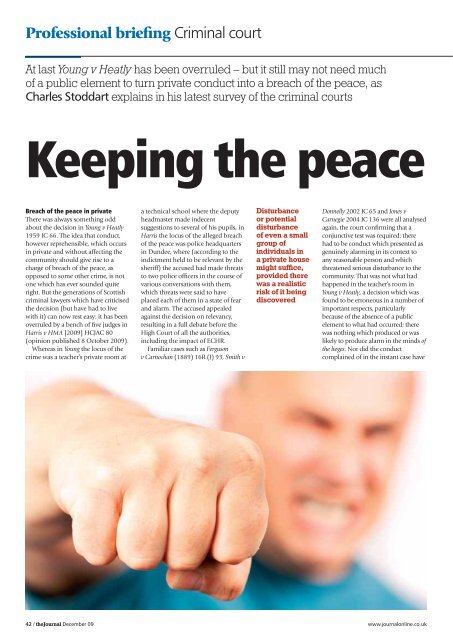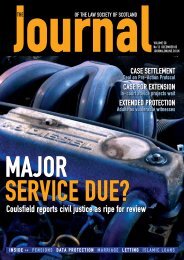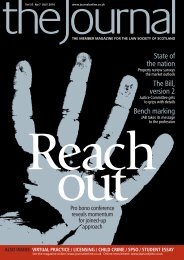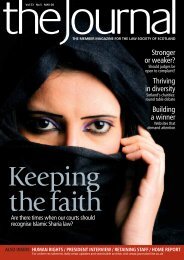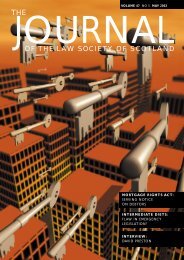Professional briefing - The Journal Online
Professional briefing - The Journal Online
Professional briefing - The Journal Online
You also want an ePaper? Increase the reach of your titles
YUMPU automatically turns print PDFs into web optimized ePapers that Google loves.
<strong>Professional</strong> <strong>briefing</strong> Criminal court<br />
At last Young v Heatly has been overruled – but it still may not need much<br />
of a public element to turn private conduct into a breach of the peace, as<br />
Charles Stoddart explains in his latest survey of the criminal courts<br />
Keeping the peace<br />
Breach of the peace in private<br />
<strong>The</strong>re was always something odd<br />
about the decision in Young v Heatly<br />
1959 JC 66. <strong>The</strong> idea that conduct,<br />
however reprehensible, which occurs<br />
in private and without affecting the<br />
community should give rise to a<br />
charge of breach of the peace, as<br />
opposed to some other crime, is not<br />
one which has ever sounded quite<br />
right. But the generations of Scottish<br />
criminal lawyers which have criticised<br />
the decision (but have had to live<br />
with it) can now rest easy: it has been<br />
overruled by a bench of five judges in<br />
Harris v HMA [2009] HCJAC 80<br />
(opinion published 8 October 2009).<br />
Whereas in Young the locus of the<br />
crime was a teacher’s private room at<br />
42 / the<strong>Journal</strong> December 09<br />
a technical school where the deputy<br />
headmaster made indecent<br />
suggestions to several of his pupils, in<br />
Harris the locus of the alleged breach<br />
of the peace was police headquarters<br />
in Dundee, where (according to the<br />
indictment held to be relevant by the<br />
sheriff) the accused had made threats<br />
to two police officers in the course of<br />
various conversations with them,<br />
which threats were said to have<br />
placed each of them in a state of fear<br />
and alarm. <strong>The</strong> accused appealed<br />
against the decision on relevancy,<br />
resulting in a full debate before the<br />
High Court of all the authorities,<br />
including the impact of ECHR.<br />
Familiar cases such as Ferguson<br />
v Carnochan (1889) 16R (J) 93, Smith v<br />
Disturbance<br />
or potential<br />
disturbance<br />
of even a small<br />
group of<br />
individuals in<br />
a private house<br />
might suffice,<br />
provided there<br />
was a realistic<br />
risk of it being<br />
discovered<br />
Donnelly 2002 JC 65 and Jones v<br />
Carnegie 2004 JC 136 were all analysed<br />
again, the court confirming that a<br />
conjunctive test was required: there<br />
had to be conduct which presented as<br />
genuinely alarming in its context to<br />
any reasonable person and which<br />
threatened serious disturbance to the<br />
community. That was not what had<br />
happened in the teacher’s room in<br />
Young v Heatly, a decision which was<br />
found to be erroneous in a number of<br />
important respects, particularly<br />
because of the absence of a public<br />
element to what had occurred: there<br />
was nothing which produced or was<br />
likely to produce alarm in the minds of<br />
the lieges. Nor did the conduct<br />
complained of in the instant case have<br />
www.journalonline.co.uk


